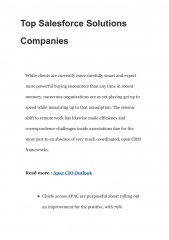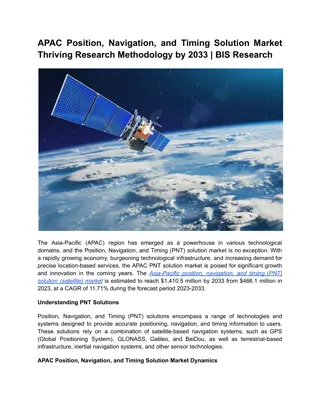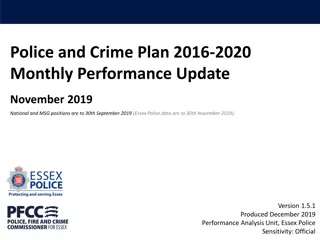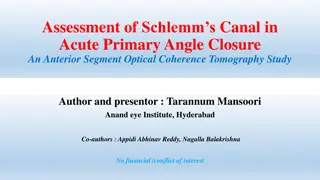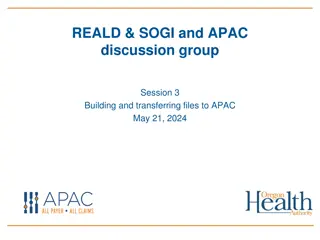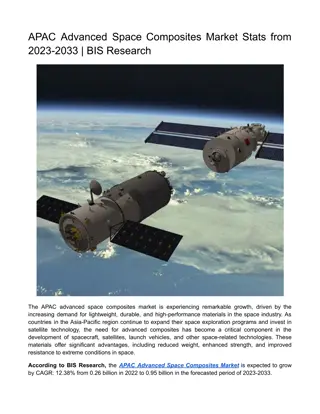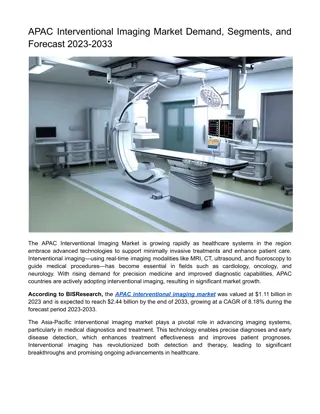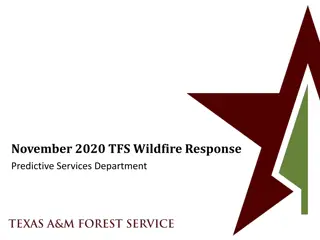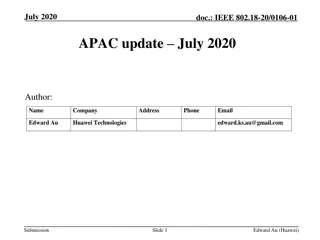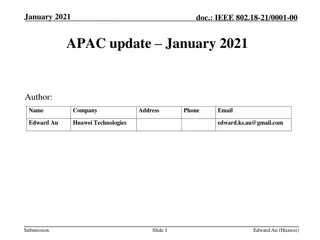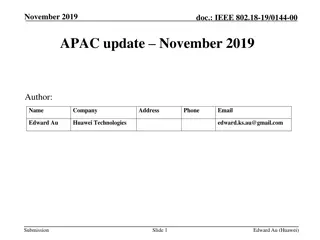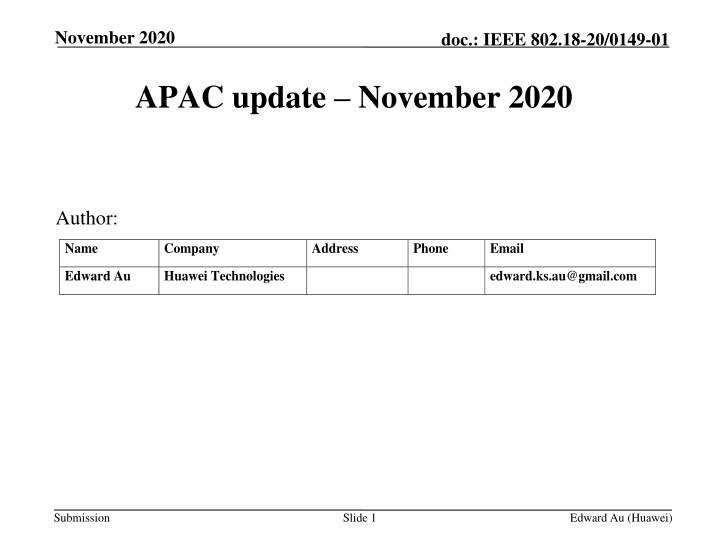
Overview of November 2020 Update on APAC Activities in IEEE 802.18-20
Explore the high-level activities in APAC related to Wi-Fi and WPAN between July and November 2020. The updates include proposed changes to the Australian Radiofrequency Spectrum Plan by ACMA, reflecting ITU Radio Regulations modifications post WRC-2019 decisions. Discover new arrangements for low interference potential devices to support 5G, IoT, and other technologies. Stay informed on the latest developments in the field.
Download Presentation

Please find below an Image/Link to download the presentation.
The content on the website is provided AS IS for your information and personal use only. It may not be sold, licensed, or shared on other websites without obtaining consent from the author. If you encounter any issues during the download, it is possible that the publisher has removed the file from their server.
You are allowed to download the files provided on this website for personal or commercial use, subject to the condition that they are used lawfully. All files are the property of their respective owners.
The content on the website is provided AS IS for your information and personal use only. It may not be sold, licensed, or shared on other websites without obtaining consent from the author.
E N D
Presentation Transcript
November 2020 doc.: IEEE 802.18-20/0149-01 APAC update November 2020 Author: Name Company Address Phone Email Edward Au Huawei Technologies edward.ks.au@gmail.com Submission Slide 1 Edward Au (Huawei)
November 2020 doc.: IEEE 802.18-20/0149-01 Background This slide deck provides a high-level overview of the activities in APAC (related to Wi-Fi and WPAN) between July and November 2020. Submission Slide 2 Edward Au (Huawei)
November 2020 doc.: IEEE 802.18-20/0149-01 Australia ACMA (1) Proposed update to the Australian Radiofrequency Spectrum Plan Information https://www.acma.gov.au/consultations/2020-08/proposed-update- australian-radiofrequency-spectrum-plan-consultation-272020 Consultation closes on September 29, 2020 Abstract: The proposed changes reflect changes to the ITU Radio Regulations because of the decisions of WRC-2019. They include new identifications for IMT (mobile broadband), maritime and satellite services, some minor editorial changes and clarification of a number of Australian footnotes, and updates reflecting domestic changes that have occurred over the past four years. The ACMA typically updates the Spectrum Plan following each WRC. Slide 3 Submission Edward Au (Huawei)
November 2020 doc.: IEEE 802.18-20/0149-01 Australia ACMA (2) Proposed update to the Australian Radiofrequency Spectrum Plan (Cont d) The proposed table of frequency allocation and the associated footnotes with tracking changes is posted: https://www.acma.gov.au/sites/default/files/2020- 08/Draft%20Australian%20Radiofrequency%20Spectrum%20Plan %202021.docx List of submissions publishes on November 10: https://www.acma.gov.au/sites/default/files/2020- 11/Submissions%20to%20IFC%2027%202020.zip The Australian Radiofrequency Spectrum Plan 2017 remains in force until it is revoked and a new Spectrum Plan is published. Submission Slide 4 Edward Au (Huawei)
November 2020 doc.: IEEE 802.18-20/0149-01 Australia ACMA (3) New arrangements for low interference potential devices Information: https://www.acma.gov.au/sites/default/files/2020-09/Variation-to- the-LIPD-Class-Licence-consultation-paper.docx https://www.acma.gov.au/sites/default/files/2020-09/Draft- Radiocommunications-Low-Interference-Potential-devices-Class- Licence-Variation-Notice-2020-No-1.docx https://www.acma.gov.au/sites/default/files/2020-09/Notice-under- subsection-136-of-Radiocommunications-Act-1992-of-proposed- variation-of-LIPD-Class-Licence-2015.docx Consultation closes on October 26, 2020 Submission Slide 5 Edward Au (Huawei)
November 2020 doc.: IEEE 802.18-20/0149-01 Australia ACMA (4) New arrangements for low interference potential devices (Cont d) Abstract ACMA plans to introduce new arrangements to support 5G, the IoT and other new technologies related to the following spectrum bands by updating the Radiocommunications (Low Interference Potential Devices) Class Licence 2015 (a.k.a. LIPD Class License): Wireless broadband in the 24.25 25.10 GHz band IoT devices in the 928 935 MHz band and VHF high bands Radiodetermination devices in the 10.50 10.55 GHz band. Submission Slide 6 Edward Au (Huawei)
November 2020 doc.: IEEE 802.18-20/0149-01 Australia ACMA (5) New arrangements for low interference potential devices (Cont d) Of interest to us: IoT devices in the 928 935 MHz band The ACMA completed a review of arrangements in the 803 960 MHz band in November 2015. The ACMA is proposing to implement decisions relating to the introduction of arrangements for IoT devices in the 928 935 MHz band from the November 2015 paper in this update to the LIPD Class Licence. These arrangements will support low-power wide-area network (LPWAN) rollouts, which include a range of emerging monitoring and control technologies. Submission Slide 7 Edward Au (Huawei)
November 2020 doc.: IEEE 802.18-20/0149-01 Australia ACMA (6) New arrangements for low interference potential devices (Cont d) Of interest to us: IoT devices in the 928 935 MHz band (cont d) Technical conditions for fixed telecommand or telemetry transmitters: Authorised on a non-exclusive basis. EIRP not to exceed 25 mW (14 dBm). Radiated power spectral density (PSD) not to exceed -14.5 dBm/kHz. A maximum duty cycle of 0.1 per cent be applied to transmitters operating under these provisions averaged over one hour on any given frequency. Submission Slide 8 Edward Au (Huawei)
November 2020 doc.: IEEE 802.18-20/0149-01 Australia ACMA (7) New arrangements for low interference potential devices (Cont d) Of possible interest to us: IoT devices in the VHF band The ACMA released the discussion paper Internet of Things Applications in the VHF High Band in July 2020. In this paper, it was proposed to establish arrangements similar to those in place in Europe for the 169.4 169.4875 MHz, 169.4875 169.5875 MHz, and 169.5875 169.8125 MHz frequency segments Submission Slide 9 Edward Au (Huawei)
November 2020 doc.: IEEE 802.18-20/0149-01 Australia ACMA (8) New arrangements for low interference potential devices (Cont d) Of possible interest to us: IoT devices in the VHF band Technical conditions for telecommand or telemetry transmitters: EIRP not to exceed 16.4 mW. 0.1 % duty cycle for 169.4 169.4875 MHz and 169.5875 169.8125 0.001% duty cycle except for 00:00 h to 06:00 h local time where the duty cycle limit is 0.1% for 169.4875 169.5875 MHz Submission Slide 10 Edward Au (Huawei)
November 2020 doc.: IEEE 802.18-20/0149-01 Australia ACMA (9) Amendment to the Short Range Devices Standard consultation Information: https://www.acma.gov.au/sites/default/files/2020-11/Amendments- to-the-SRD-Standard-consultation-paper.docx https://www.acma.gov.au/sites/default/files/2020- 11/Radiocommunications-Short-Range-Devices-Amendment- Standard-2020-No-1.docx Consultation closes on December 18, 2020 Submission Slide 11 Edward Au (Huawei)
November 2020 doc.: IEEE 802.18-20/0149-01 Australia ACMA (10) Amendment to the Short Range Devices Standard consultation (Cont d) Background: The LIPD Class Licence authorises the operation of specified devices, while the Short Range Devices Standard regulates the technical performance of devices supplied to the Australian market. The Short Range Devices Standard specifies that the applicable standard for devices is either the standard listed in the LIPD Class Licence or, if no standard is listed, the Standards Australia standard AS/NZS 4268:2012 Radio equipment and systems Short range devices Limits and methods of measurement , which specifies minimum performance requirements and methods of measurement for short-range devices (AS/NZS 4268). Submission Slide 12 Edward Au (Huawei)
November 2020 doc.: IEEE 802.18-20/0149-01 Australia ACMA (11) Amendment to the Short Range Devices Standard consultation (Cont d) Proposal To update the reference from AS/NZS 4268:2012 to AS/NZS 4268:2017 To allow the use of international test method standards as alternatives to AS/NZS 4268 by referencing four generic ETSI standards and the FCC Rules: ETSI EN 300 220-1 ETSI EN 300 330 ETSI EN 300 440 ETSI EN 305 550-1 FCC Rules Title 47 (Telecommunications) Part 15-Radio Frequency Devices. Submission Slide 13 Edward Au (Huawei)
November 2020 doc.: IEEE 802.18-20/0149-01 China MIIT Mandatory Electromagnetic radiation exposure limit of mobile communication terminal devices Background China MIIT plans to replace the existing national standard GB 21288-2007 with GB 21288-2020, which is applicable to mobile communication terminal devices that work between 100 kHz and 300 GHz and are within 20cm of the human body when in use. Information: https://www.miit.gov.cn/zwgk/wjgs/art/2020/art_fe0b39c37fb94f15 bb13c45d9e205110.html GB 21288-2020 https://www.miit.gov.cn/cms_files/filemanager/oldfile/miit/n114629 5/n7281310/c8113089/part/8113160.zip national standards for approval: Submission Slide 14 Edward Au (Huawei)
November 2020 doc.: IEEE 802.18-20/0149-01 Japan MIC (1) Call for opinions on the draft frequency allocation plan Information (consultation closes on September 18, 2020): https://www.soumu.go.jp/menu_news/s-news/01kiban09_02000370.html Abstract: Based on the decisions of WRC 2019, partial amendments to the ITU Charter and the Radio Regulations attached to the Convention will come into effect on January 1, 2021. Domestic changes over the past few years are also included. Main changes include: Frequency allocation for NAVDAT in the 415-526.5kHz band Frequency allocation to space operations on non-geostationary satellites for short-term missions in the 137-138MHz and 148- 149.9MHz bands Frequency allocation for the use of VHF data exchange system on satellites Introduction of Iridium satellite system as a new satellite system of GMDSS. Slide 15 Submission Edward Au (Huawei)
November 2020 doc.: IEEE 802.18-20/0149-01 Japan MIC (2) Call for opinions on the draft frequency allocation plan Decision is made on October 12, 2020, with some minor changes: https://www.soumu.go.jp/menu_news/s-news/01kiban09_02000381.html Submission Slide 16 Edward Au (Huawei)
November 2020 doc.: IEEE 802.18-20/0149-01 Korea MSIT (1) Consultation on partial revision (draft) of Korea Frequency Distribution Table Information: http://english.msip.go.kr/web/msipContents/contentsView.do?cateId =_law4&artId=3001321 Consultation closes on September 30, 2020 Proposal: To revise the footnote K125B in allowing UWB communications from 3.735 to 4.8 GHz and 6.0 to 10.2 GHz to 4.2 - 4.8 GHz and 6.0 - 10.2 GHz Submission Slide 17 Edward Au (Huawei)
November 2020 doc.: IEEE 802.18-20/0149-01 Korea MSIT (2) Announcement on releasing 6 GHz band for unlicensed use Information: https://www.msit.go.kr/web/msipContents/contentsView.do?cateId= _policycom2&artId=3140715 In the announcement: The MCIT made an administrative notice on related technical standards in June of this year that collects opinions between June 20, 2020 and August 24, 2020. Anyone can freely use the entire 6 GHz indoors under 250 mW. Connections between devices such as tethering are in the 5925 6445 MHz band. It can be used without distinction between indoors and outdoors Submission Slide 18 Edward Au (Huawei)
November 2020 doc.: IEEE 802.18-20/0149-01 Korea MSIT (3) RECAP: Consultation on revised technical standards for radio equipment in 5 GHz and 6 GHz bands Comments due on August 24, 2020. For details: http://english.msip.go.kr/web/msipContents/contentsView.do?cateId =_law4&artId=2942268 Motivation: To enable high-quality data service and accelerate the adoption of 5G convergence services using 5G-class unlicensed technology (e.g, WiFi 6E, 5G NR-U) in the 6 GHz band. NOTE the same motivation as the previous consultation. Submission Slide 19 Edward Au (Huawei)
November 2020 doc.: IEEE 802.18-20/0149-01 Korea MSIT (4) RECAP: Consultation on revised technical standards for radio equipment in 5 GHz and 6 GHz bands (Cont d) For radio equipment in 5925-6425 MHz: Occupied frequency bandwidth Power density including absolute antenna gain Remarks 0.5 MHz min 20 MHz max 1 dBm/MHz or less The power density including the absolute gain of the antenna should be an average value Drones are prohibited. Built-in wireless devices used in automobiles are allowed to operate in 6085-6425 MHz. 20 MHz min 40 MHz max -2 dBm/MHz or less 40 MHz min 80 MHz max -5 dBm/MHz or less 80 MHz min 160 MHz max -8 dBm/MHz or less Submission Slide 20 Edward Au (Huawei)
November 2020 doc.: IEEE 802.18-20/0149-01 Korea MSIT (5) RECAP: Consultation on revised technical standards for radio equipment in 5 GHz and 6 GHz bands (Cont d) For indoor wireless devices in 5925-7125 MHz: Occupied frequency bandwidth Power density including absolute antenna gain Remarks 160 MHz 2 dBm/MHz or less The power density including the absolute gain of the antenna should be an average value Limited to equipment that is installed and operated by being connected to the power in the building or connected to another equipment. Prohibited use in vehicles such as automobiles, aircraft, railroads, ships, and drones Submission Slide 21 Edward Au (Huawei)
November 2020 doc.: IEEE 802.18-20/0149-01 Korea MSIT (6) RECAP: Consultation on revised technical standards for radio equipment in 5 GHz and 6 GHz bands (Cont d) New conditions: Frequency tolerance deviation should be within 20 10-6. Out-of-band emission should have an average power density of 27 dBm/MHz or less, including the absolute antenna gain. For peak value, it should be less than -34 dBm/MHz at a frequency outside the 5925-6425 MHz band. Modulation type should be digital. Listen before talk should be used. Submission Slide 22 Edward Au (Huawei)
November 2020 doc.: IEEE 802.18-20/0149-01 Korea MSIT (7) Consultation on the partial revision (draft) of Korea Frequency Distribution Table Information: http://english.msip.go.kr/web/msipContents/contentsView.do?cateId =_law4&artId=3069996 Consultation closes on October 31, 2020 Abstract: In order to update the global frequency after the decision of WRC 2019 and in consideration of domestic frequency usage conditions. Of possible interest to us are the following frequency bands: 5150 5350 MHz , 5350 5850 MHz 64 76 GHz (IMT) Submission Slide 23 Edward Au (Huawei)
November 2020 doc.: IEEE 802.18-20/0149-01 Malaysia MCMC Usage of Personal Radio Service Device(s) Information https://www.mcmc.gov.my/skmmgovmy/files/65/6517f91b-9628- 4781-a718-d315cf9c485a.pdf Abstract Effective from January 1, 2023, personal radio service device(s) operating in the 477.0125 MHz to 477.4875 MHz and 477.5250 MHz to 477.9875 MHz frequency bands will longer be permitted. Note It is the third amended notice. Submission Slide 24 Edward Au (Huawei)
November 2020 doc.: IEEE 802.18-20/0149-01 New Zealand RSM (1) Dedicated spectrum band plans and licensing for unmanned aircraft Information https://www.aviation.govt.nz/assets/airspace-and- aerodromes/navigation/CAA_MBIE_Discussion_Document_Unman ned_Dedicated_Radio_Spectrum_August_2020_final.pdf Consultation closes on October 31, 2020. Abstract The Civil Aviation Authority (CAA), in conjunction with RSM, have a developed a position paper on opening up a new band of spectrum at 5 GHz for unmanned aircraft command and control. This paper looks at potential band plans, as well as access regimes for unmanned aircraft flown under civil aviation rules. Submission Slide 25 Edward Au (Huawei)
November 2020 doc.: IEEE 802.18-20/0149-01 New Zealand RSM (2) Dedicated spectrum band plans and licensing for unmanned aircraft (Cont d) Problem statement: The status quo of all Unmanned Aircraft (UA) or Drones operating on shared, non-protected spectrum is not sustainable. Currently, command and controls links for unmanned aircraft operations typically operate in the frequency ranges 2400-2483.5 MHz, 5150-5350, and 5470-5875 MHz. Proposal To move unmanned aircraft operations to part of the C-band (5030- 5091 MHz). To examine potential licensing options to manage any dedicated spectrum. Submission Slide 26 Edward Au (Huawei)
November 2020 doc.: IEEE 802.18-20/0149-01 Singapore IMDA (1) Consultation: Security Requirements for Residential Gateways Information: https://www.imda.gov.sg/regulations-and- licensing/Regulations/consultations/Consultation- Papers/2020/Security-Requirements-for-Residential-Gateways Consultation closes on May 15, 2020 Proposal that is of interest to us: Paragraphs 4.4 (Wireless Access Protection) and 4.5 (Data Protection) maybe of interest to Wi-Fi community: E.g., 4.4b: The Residential Gateway shall use AES encryption, with at least WPA2 protection by default. If weaker security protection such as WEP or WPA is chosen by users, warning(s) of the higher security risk to use these encryption algorithms shall be displayed. Submission Slide 27 Edward Au (Huawei)
November 2020 doc.: IEEE 802.18-20/0149-01 Singapore IMDA (2) Consultation: Security Requirements for Residential Gateways (Cont d) Decision is made on October 12, 2020: A residential gateway can use other secure encryption algorithms including AES. While the setup of a guest network helps further protect the residential gateway, it may not be widely used currently by user. IMDA do not mandate for residential gateways to have this feature. Data elements used by residential gateways need not be encrypted as long as they are salted and hashed. IMDA will leave it to manufacturers to decide whether to encrypt the data elements. Submission Slide 28 Edward Au (Huawei)
November 2020 doc.: IEEE 802.18-20/0149-01 Singapore IMDA (3) Consultation: Security Requirements for Residential Gateways (Cont d) Decision paper: https://www.imda.gov.sg/-/media/Imda/Files/Regulations-and- Licensing/Regulations/Consultations/2020/Security-Requirements-for- Residential-Gateways/2020-10-12-RGConsultation-DecisionPaper.pdf?la=en Technical specification: https://www.imda.gov.sg/-/media/Imda/Files/Regulation-Licensing-and- Consultations/ICT-Standards/Telecommunication-Standards/Radio- Comms/IMDA-TS-RG-SEC.pdf?la=en Key cybersecurity requirements: https://www.imda.gov.sg/-/media/Imda/Files/News-and-Events/Media- Room/Media-Releases/10/Key-Cybersecurity-Requirements-by- IMDA.pdf?la=en Submission Slide 29 Edward Au (Huawei)
November 2020 doc.: IEEE 802.18-20/0149-01 Thailand NBTC Public hearing on radio and television broadcasting stations that are exempt from obtaining a license Information: Link (involve Thai language in the URL) Consultation closes on October 16, 2020 Proposal: Frequency (MHz) 500 2,000 2,000 300,000 EIRP (watts) 0.5 2 Submission Slide 30 Edward Au (Huawei)
November 2020 doc.: IEEE 802.18-20/0149-01 Vietnam MIC (1) Legal document: National technical regulation on wideband data transmission equipment operating in the 2.4 GHz band Purpose: This latest national technical regulation specifies essential radio requirements and conformance test procedures for wideband data transmission equipment operating in the 2.4 GHz band. It is intended to supersede the 2011 standards. Information: https://mic.gov.vn/Pages/VanBan/14605/35_2020_TT-BTTTT.html https://mic.gov.vn/Upload_Moi/VanBan/QCVN-54-FINAL-.DOCX Date issued: November 6, 2020 Effective date: January 7, 2021 Submission Slide 31 Edward Au (Huawei)
November 2020 doc.: IEEE 802.18-20/0149-01 Vietnam MIC (2) Legal document: National technical regulation on Short Range Device (SRD) - Radio equipment to be used in the 1 GHz to 40 GHz frequency range Purpose: This latest National technical regulation specifies essential radio requirements and conformance test procedures for licence exempt Short Range Devices (SRDs) operating in the frequency bands within the range of 1 GHz to 40 GHz. Note: Frequency bands of SRD are listed as follows: 2400 2483.5 MHz, 5725 5850 MHz 2446 2454 MHz 24.00 24.25 GHz Submission Slide 32 Edward Au (Huawei)
November 2020 doc.: IEEE 802.18-20/0149-01 Vietnam MIC (3) Legal document: National technical regulation on Short Range Device (SRD) - Radio equipment to be used in the 1 GHz to 40 GHz frequency range (Cont d) Information: https://mic.gov.vn/Pages/VanBan/14604/34_2020_TT-BTTTT.html https://mic.gov.vn/Upload_Moi/VanBan/3.-QCVN-74-2020-SRD-1- 40-GHZ-2.11.2020.DOCX Date issued: November 6, 2020 Effective date: January 7, 2021 Submission Slide 33 Edward Au (Huawei)

